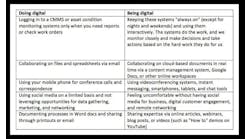It makes perfect sense.
As noted in the State of Initiative survey results here, increasing productivity is the main benefit enterprises seek in their digital transformations.
But that’s a broad concept—productivity—so we dug a little deeper with Canvass Analytics CEO and founder Humera Malik, focusing on her area of expertise: artificial intelligence. Take a look…
Smart Industry: How is artificial intelligence (AI) driving productivity improvements in this era of digital transformation?
Humera: Digital transformation is the conduit for AI to deliver significant contributions in plant productivity. From every vantage point, AI is driving better, faster insights from plant operations and plant assets by harnessing the value of large volumes of data and then prompting automation across the entire production line—be it better capacity planning, predicting equipment failures, optimizing production processes or even reducing scrap by predicting part quality.
Smart Industry: What fears do enterprises have in adopting artificial-intelligence initiatives? Are these concerns warranted?
Humera: In terms of AI adoption, one of the biggest hurdles that enterprises struggle with is data. What data do we need? Is it the right data? How much do need? Where will we get it from? Their concerns are 100% warranted because, for so long, data was only being generated in small batches and in siloed segments of operations. In this new digital era, data is constantly changing the course of how decisions will be made, how parts will be produced, how equipment will be run, how maintenance teams will plan, etc. This leads into the second hurdle—how AI will impact manpower and resources. Will I need to retrain my staff? Will I need new skillsets? Will I need fewer resources or will I need more? While AI presents new opportunities for autonomous plant operations, the need for the human factor is still highly relevant. We see AI as a means to elevate traditional resources to become more productive by having better, faster insights to improve decision-making.
Smart Industry: What are the low-hanging fruits—those productivity gains that can be realized quickly with AI, then used to validate wider efforts?
Humera: Process improvement, predictive maintenance and energy efficiency. For example, we have seen AI used to predict asset failure, which resulted in the ability to plan resources and materials in order to minimize downtime while lowering repair-part-expedition costs. In another example, AI has been used to optimize the runtime of co-generation turbines, therein minimizing fuel costs while reducing GHG emissions. In both cases, productivity gains immediately affected the bottom line, which makes the business case for AI initiatives that much more compelling.
Want more? Click the image to explore our 2018 State of Initiative Report.
Smart Industry: As productivity increases with the adoption of AI, what new roles are emerging to manage these efforts?
Humera: Opportunities are starting to surface around automation and innovation, which will require more engineering and higher-functioning business roles. As these new roles emerge, each will leverage AI in some fashion to optimize operations.
Smart Industry: What’s next? What excites you on the horizon of AI in the industrial space?
Humera: What we see now with AI is just the tip of the iceberg. While this was originally used to merely address big data problems, enterprises now understand the power of AI and its ability to uncover incredible insights about their operations. As more and more enterprises begin to develop full data strategies, AI will optimize every aspect of operations—performance, energy, quality, etc. AI will start to answer complex questions—How do you run a plant based on real-time demand? How much energy is required to produce a single component? These are exciting times, and we’re excited to be in the middle of all of it.



